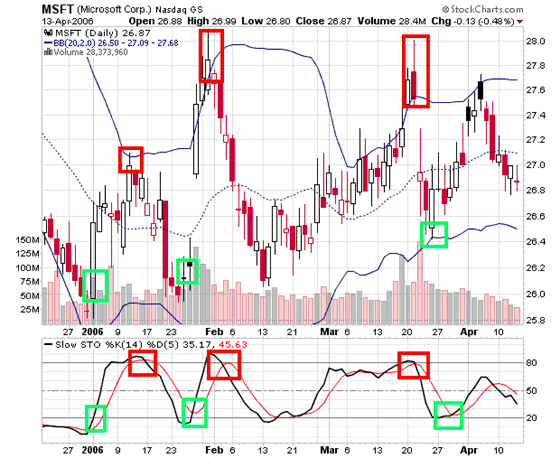Bollinger on Bollinger bands
Post on: 15 Июль, 2015 No Comment

in support of *serious* forex education.
Bollinger on Bollinger bands
Bollinger bands are considered to be one of the most popular tools of technical analysis. Although the simplest (and most widely known) version of this technical indicator does not predict the direction of the market, it reliably anticipates periods of low and high volatility. When used wisely, this information is usually sufficient for profitable trading of breakouts. My own profitable scalping strategy basically consists of breakout trading based on Bollinger bands. What else can this technical indicator offer to a forex trader? Let us ask the inventor of Bollinger bands himself.
John A. Bollingers book Bollinger on Bollinger Bands describes in detail different uses of the famous technical indicator. The featured case studies demonstrate usefulness of Bollinger bands in a number of financial markets, including stocks and forex. On 256 pages, the author tries both to teach the basics and to reveal some advanced applications that cannot be found elsewhere. Although a novice trader may find this systematic approach attractive, a more experienced reader would be tempted to skip few introductory chapters. Nevertheless, it would be a mistake to drop the book altogether.
The book starts with an insipid overview of basic charts, time frames, and trading psychology. The first five chapters may be useful for beginners, but anyone already trading currencies will probably just skip them. Only after this lengthy introduction, Bollinger actually explains what his technical analysis tool is about. He also places his own work in the historical context of other similar indicators (bands and envelopes). This is certainly interesting, but not as useful as the rest of the book.
Perhaps the most interesting topic is covered by the second part of the book. Bollinger goes beyond the bands themselves, introducing two less-known but very useful indicators: %b and Bandwidth. The former measures in a systematic way whether the price is closer to the upper or the lower band. This information is often regarded as an indicator of overbought or oversold markets. As the name indicates, Bandwidth normalizes the width of the bands. The resulting number can be used to anticipate breakouts. Bollinger on Bollinger Bands succinctly explains how you can compute %b and Bandwidth using the standard forex charts and data feeds. Examples of practical application are discussed in great detail in the third part of the book.
What makes the book extremely valuable for breakout trading, it devotes a significant amount of space to the so-called Squeeze pattern. The Squeeze is a prolonged contraction of Bollinger bands followed by an explosive breakout of price and widening of the bands. This forex chart pattern is sought after by many breakout traders, including myself. I have never seen such a comprehensive discussion of the Squeeze before reading Bollinger on Bollinger Bands. As an active forex trader, I would prefer even more information about how to identify false breakouts that considerably reduce my profit from breakout trading. But I doubt John Bollinger (or anyone else, for that matter) can offer a silver bullet here.
Building on his own trading experience, the author also shows how a trader can use Bollinger bands to identify relevant W and M patterns on charts. For those who do not know what I am talking about, a popular example of an M pattern anticipating an immediate drop in price is the notorious “head-and-shoulders”. Although I do not look at these chart patterns while trading, many people do. It is nice to know that Bollinger bands can give some scientific support to what I have considered essentially an art.
Other chapters propose practical trading strategies that combine Bollinger bands with other technical indicators, such as MFI, AD, and MACD. Here, John Bollinger is very specific and his books reads more like a how-to manual. Although I have not tested any of Bollingers trading strategies described in this section of the book, I would certainly not discard them. The authors company Bollinger Capital Management Inc. built upon these techniques, serves clients since 1988.

Bollinger on Bollinger Bands also teaches to directly apply Bollinger bands on other technical indicators. Although the traditional version of the bands takes a simple moving average as its input, there is no reason why the bands could not be constructed around RSI, for instance. In fact, John Bollinger persuasively argues that such normalization may make other indicators more meaningful because it would create trading signals robust across different periods and even markets.
The final chapter concerns day trading. I think this part of the book is a bit too abstract to be useful. Its sole purpose is apparently to prove Bollingers point: a method of technical analysis originally designed for longer periods may be easily applied to day trading. As someone who uses Bollinger bands for scalping profits from intra-day breakouts, I can only concur. However, I would be more interested in a more practical treatment of this subject.
To conclude my book review, let me quote John Bollinger himself: “Life is complicated enough as it is. Stick to the basics and leave the wild stuff to those so inclined.” I cannot than subscribe to these words. Many traders specialized in technical analysis construct complex and extremely sophisticated models in order to “predict” patterns in their historical data. But too many parameters can make a model unreliable in the ever-changing environment of the foreign exchange market. Why not to base forex trading on one simple and robust method of technical analysis? If you want to keep things simple, Bollinger bands are a very powerful technical indicator. If you want to give them a shot, Bollinger on Bollinger bands is the best guidebook you can find.
Bollinger on Bollinger bands sells for $32.97 at Amazon. I list other books on technical analysis that I like at Forex Learning Site.














